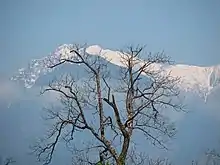Lower Dibang Valley district
The Lower Dibang Valley district (Pron:/dɪˈbæŋ/) is an administrative district in the state of Arunachal Pradesh in northeastern India. It is the tenth least populous district in the country (out of 707).[2]
Lower Dibang Valley district | |
|---|---|
 View of the Dibang from Bara Golai north of Roing | |
 Location of Lower Dibang Valley district in Arunachal Pradesh | |
| Country | |
| State | Arunachal Pradesh |
| Headquarters | Roing |
| Population (2011) | |
| • Total | 54,080[1] |
| Demographics | |
| • Literacy | 70.4%[1] |
| • Sex ratio | 919[1] |
| Time zone | UTC+05:30 (IST) |
| Website | roing |
History

The area of the present district was an integral part of the Chutiya Kingdom from the 12th to the 16th century. In June 1980, Dibang Valley district was created out of part of Lohit district.[3] On 16 December 2001, Dibang Valley district was bifurcated into Dibang Valley district and Lower Dibang Valley district.[3] This district is credited significantly for producing 1st in the state of Arunachal, the likes such as:-
1) Mukut Mithi, the first person to become a Lieutenant Governor, formar chief minister, Member of Parliament (RS) and State Congress president from the state of Arunachal Pradesh.
2) Jomin Tayeng, first IAS (direct recruit through UPSC, 1967), first L.L.B (Law Graduate, 1967) in Arunachal Pradesh.
3) Tine Mena (1st women to climb Mt. Everest) from Arunachal Pradesh.
4) Anayok James Tayeng, first IAS (Indian Administrative Service) officer (by induction), 1964.
5)Gora Pertin,First pro temporary speaker of Lagislative Assembly (1975)
6) Dr. Marak Pertin, first Navy Doctor from Arunachal Pradesh.
7) Mrs. Rukluki Lego, First ANM (Auxiliary Nursing Midwife), 1951 batch from Arunachal Pradesh.
8) Dugyon Lego, the first person to publish a book called PADAM KITAB in Roman Script for elementary education in indigenous dialect in the year 1935.
Geography
The district headquarters of the district is Roing. Before it was carved out on 16 December 2001, Anini was the district headquarters.[4]
Transport
The 2,000-kilometre-long (1,200 mi) proposed Mago-Thingbu to Vijaynagar Arunachal Pradesh Frontier Highway along the McMahon Line,[5][6][7][8] (will intersect with the proposed East-West Industrial Corridor Highway) and will pass through this district, alignment map of which can be seen here and here.[9]
Divisions
There are two Arunachal Pradesh Legislative Assembly constituencies located in this district: Dambuk and Roing. Both are part of Arunachal East Lok Sabha constituency.[10]
Demographics
According to the 2011 census Lower Dibang Valley district has a population of 54,080,[1] roughly equal to the nation of Saint Kitts and Nevis.[11] This gives it a ranking of 630th in India (out of a total of 640).[1] The district has a population density of 14 inhabitants per square kilometre (36/sq mi) .[1] Its population growth rate over the decade 2001–2011 was 7.01%.[1] Lower Dibang Valley has a sex ratio of 919 females for every 1000 males,[1] and a literacy rate of 70.38%.[1]
Languages
Major Languages spoken include Idu Mishmi and Adi. Hindi is studied extensively by children in kindergarten since the 1970s. Most of the citizens now understand and speak Hindi. Several other languages are spoken too in various pockets such as Nepali, Assamese, etc. by people who primarily provide labor in farms, tea gardens, etc. English too is abundantly spoken by educated citizens.
Flora and fauna
The district is rich in wildlife. Rare mammals such as Mishmi takin, red goral, elephant, wild water buffalo and leaf muntjac occur while among birds there is the rare Sclater's monal, Blyth's tragopan, rufous-necked hornbill, Bengal florican, white-winged wood duck.[12] A flying squirrel, new to science, i.e., Mishmi Hills giant flying squirrel (Petaurista mishmiensis) also occurs in this district.[13]
In 1980 Lower Dibang Valley district became home to the Mehao Wildlife Sanctuary, which has an area of 282 km2 (108.9 sq mi).[14] A new subspecies of hoolock gibbon has been described from this area which has been named as Mishmi Hills hoolock H. h. mishmiensis.[15]
References
- "District Census 2011". Census2011.co.in. 2011. Retrieved 30 September 2011.
- "District Census 2011". Census2011.co.in. 2011. Retrieved 30 September 2011.
- Law, Gwillim (25 September 2001). "Districts of India". Statoids. Retrieved 11 October 2011.
- "Official Website of the Lower Dibang Valley District". Archived from the original on 26 May 2011. Retrieved 2 April 2010.
- Dipak Kumar Dash. "Top officials to meet to expedite road building along China border". The Times of India. Retrieved 27 October 2014.
- "Narendra Modi government to provide funds for restoration of damaged highways". www.dnaindia.com. Retrieved 27 October 2014.
- "Indian Government Plans Highway Along Disputed China Border". Ankit Panda. thediplomat.com. Retrieved 27 October 2014.
- "Govt planning road along McMohan line in Arunachal Pradesh: Kiren Rijiju". Live Mint. Retrieved 26 October 2014.
- "China warns India against paving road in Arunachal". Ajay Banerjee. tribuneindia.com. Retrieved 26 October 2014.
- "Assembly Constituencies allocation w.r.t District and Parliamentary Constituencies". Chief Electoral Officer, Arunachal Pradesh website. Archived from the original on 13 August 2011. Retrieved 21 March 2011.
- US Directorate of Intelligence. "Country Comparison:Population". Retrieved 1 October 2011.
Saint Kitts and Nevis 50,314 July 2011 est.
- Choudhury, Anwaruddin (2008) Survey of mammals and birds in Dihang-Dibang biosphere reserve, Arunachal Pradesh. Final report to Ministry of Environment & Forests, Government of India. The Rhino Foundation for nature in NE India, Guwahati, India. 70pp.
- , Choudhury, Anwaruddin (2009).One more new flying squirrel of the genus Petaurista Link, 1795 from Arunachal Pradesh in north-east India. The Newsletter and Journal of the RhinoFoundation for nat. in NE India 8: 26–34, plates.
- Indian Ministry of Forests and Environment. "Protected areas: Arunachal Pradesh". Archived from the original on 23 August 2011. Retrieved 25 September 2011.
- .A. U. Choudhury (2013). Description of a new subspecies of hoolock gibbonHoolock hoolock from North East India. The Newsletter & Journal of the Rhino Foundation for nat. in NE India 9: 49–59.